Chopped Herring and the Making of the American Kosher Certification System
A few days before Passover in 1986, Rabbi Eliyahu Shuman of the Star-K kosher certification agency noticed some suspicious jars of Acme Chopped Herring in the Passover section of Shapiro’s supermarket in Pikesville, Maryland. They were certified kosher by Kof-K, another agency, but they did not bear a kosher-for-Passover label. Some of the herring had already been sold.
Shuman and his colleagues at Star-K worried about what kind of vinegar had been used to flavor the herring. Vinegar contains alcohol, which, if derived from wheat or corn, renders it impermissible for Passover. Before issuing a consumer alert or ordering a product recall, however, Star-K officials decided to launch an investigation. If the vinegar turned out to be made with synthetic alcohol, it would be kosher for Passover, as would the herring, and no harm would come to consumers who had already purchased it.
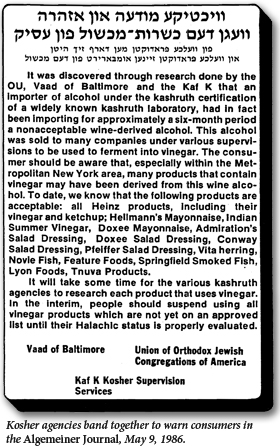
The herring company sent Shuman to the vinegar supplier, who, in turn, sent him to the alcohol manufacturer, a French company called Sofecia. When Shuman asked whether the alcohol was derived from wheat or corn, Sofecia shocked him with the news that, in fact, it was derived from grapes. Under Jewish dietary laws, special restrictions apply to grape juice and its derivatives, such as wine and vinegar. In order to be kosher, these products must be produced exclusively by Jews. (The origin of this rule lies in an ancient rabbinic prohibition against benefitting from items used in pagan worship and a concern that wine produced by non-Jews might have been so used.) Sofecia produced marc alcohol, which is extracted from the solid remains of grapes that have been pressed in winemaking. These solid remains, which consist of skins, pulp, seeds, and stems, are known as pomace, or marc in French, and they are, under Jewish law, technically a form of wine. What all this meant was that the vinegar was not kosher for Passover or any other time of the year—it was simply not kosher.
Sofecia’s marc alcohol had been erroneously certified as kosher by the OK kosher certification agency, under the direction of Rabbi Berel Levy, who prided himself on his meticulousness in verifying the kosher status of ingredients. “My father was a pioneer in kashrus in that he was the first one who insisted on going back to the source of any ingredient,” recalls his son, Rabbi Don Yoel Levy, who today directs OK. Berel Levy occasionally discovered problems that other agencies had missed, and when he did, he was frequently very public about it.
Upon discovering that vinegar produced with Sofecia’s marc alcohol was not kosher, Star-K officials wondered what other kosher-certified products, beyond Acme Chopped Herring, might contain it. They immediately contacted Levy and alerted the other major certification agencies that might have relied on his certification. Star-K, Kof-K, and the Orthodox Union (OU)—the nation’s largest certification agency—published consumer alerts, issued a ban on the use of OK-certified vinegar, and ordered their food company clients to recall products containing vinegar. The list of suspect products was extraordinarily long because the agencies had no way of determining which particular batches of vinegar or consumer products contained the erroneously certified marc alcohol. To be safe, the agencies ordered the destruction of products even suspected of containing it. “Millions and millions of dollars of product was thrown out,” recalls Rabbi Zushe Blech, who worked for the OU at the time.
We’re talking about pickles, we’re talking about ketchup, we’re talking about mustard—look at a list of products that contain vinegar and your head will spin. . . . Companies such as Heinz . . . their whole factories had to be kashered [ritually cleaned] because they were using treyf alcohol, which they bought in good faith. They didn’t do anything wrong. The OU thought it was kosher, and it turns out that it wasn’t.
In his own defense, Levy claimed that Sofecia had misled him about the production of its alcohol. He denounced the other certification agencies as hypocrites, alleging that under their supervision, “vinegar companies had been buying alcohol from Sofecia since 1980 when it had no supervision at all. But no one was concerned with wine alcohol then. Who knew of such a thing?” The alcohol in question—ethyl alcohol—was normally made from grain or synthetically, and the general practice among kosher certification agencies was to assume that all ethyl alcohol was kosher. Due to a European wine glut in the 1970s, however, companies such as Sofecia began to distill ethyl alcohol from grapes. Moreover, Levy argued there were good halakhic grounds to argue that the products affected were not in fact rendered unkosher by the small amounts of marc alcohol involved.
His rivals accused Levy of lax supervision and of not understanding the production process. Sofecia published an open letter explaining that it was unaware that ethyl alcohol distilled from grapes posed a problem, that Levy had never raised the issue, and that no one from OK ever inspected the production facilities (a charge that Levy vigorously denied). When the other certification agencies suggested to OK clients that they switch certification agencies, Levy accused them of exploiting the scandal for economic gain. A year after the scandal broke, Berel Levy died. “He had so much aggravation from it,” recalled Don Yoel Levy, “that he passed away.”
The vinegar scandal threatened to erode consumer confidence in the reliability of kosher certification that had taken decades to build. The traditional means of regulating kosher trade in the Old World had been centralized communal control backed by government power, but this proved impossible in America, with its religious voluntarism and free markets. In the absence of the Old World system, fraud, racketeering, and violence were rampant in the American kosher food industry of the early part of the 20th century. The problem of kosher fraud proved too big for even government regulators. In the 1930s, New York City’s Department of Markets employed six full-time kosher inspectors in addition to the ten inspectors from the State Kosher Enforcement Bureau, but they couldn’t possibly police the 18,000 kosher food establishments operating in the city. Government investigators and industry insiders estimated that somewhere between forty and sixty percent of the meat sold as kosher at the time was treyf. Meanwhile, food companies signaled kosher certification by placing a generic “K” on food packages. The identity and integrity of the supervising rabbi was unknown to consumers, and, in many cases, there was, in fact, no rabbinic supervision whatsoever.
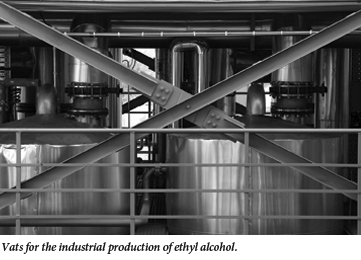
All of this changed with the rise of a new regulatory institution: the private kosher certification agency. These agencies created individual brands based on reliability. Each agency placed a distinctive symbol on products that it certified, symbols that kosher consumers learned to recognize and came to trust. (The Orthodox Union’s O-U is the oldest and most widely recognized.) The agencies backed their brands with concrete measures that helped them avoid mistakes and prevent misconduct. They instituted multiple levels of management oversight to supervise kosher inspectors and provided professional training in Jewish dietary laws, food technology, and ethics.
By the 1980s, thanks to the rise of brand competition among the OU, OK, Kof-K, and Star-K—known collectively as the “Big Four”—kosher certification had become much more reliable, or so it seemed until the vinegar scandal. Giving voice to widespread concern among consumers, the president of the National Council of Young Israel, Harold Jacobs, denounced not merely OK but all the agencies:
The slow and incomplete release of information concerning the wine vinegar incident [is] typical of the delaying and stonewalling tactics used by many of the kashruth supervisory agencies, adding to the confusion and distrust of the consuming public. Seven weeks after the incident was discovered . . . the kosher consumer has not been given a complete list of those products affected or unaffected, nor an adequate explanation of how the mistake happened in the first place.
He warned that “rumors of other serious lapses in kashruth supervision continue to spread” and that “unless the kashruth agencies accept their responsibility, kosher consumers will be compelled to repudiate the reliability of these national supervisions and be forced to go back to an earlier standard, when we relied exclusively on the judgment of our individual rabbis.”
In a fit of hyperbole, Jacobs compared the vinegar scandal to the 1986 Chernobyl nuclear disaster. Although the contamination of pickles and mustard hardly seems comparable to the radioactive fallout from Chernobyl, the juxtaposition highlights an important feature of the kosher certification industry. Political scientist Joseph Rees describes nuclear utilities as “hostages of each other” because “a single catastrophic accident . . . at any one U.S. nuclear plant would have ruinous consequences for the entire industry.” According to Rees, the 1979 nuclear accident at Three Mile Island demonstrated to nuclear utilities that “the insufficiency and failure of one of them has a potential for destroying the credibility of all the others.”
Similarly, the vinegar scandal showed that industrial food production makes kosher certification agencies highly interdependent. A mistake by one agency has potentially widespread and serious implications for agencies that rely on it later in the production process, and any resulting public scandal can damage the credibility of the kosher certification industry as a whole. As Jacobs pointed out “in a highly centralized and technologically sophisticated kosher food industry, there is, in fact, only one kashruth standard, regardless of the symbol on the package, and that standard will be determined by the lowest common denominator of supervision and reliability.” He called on certifiers to “assume mutual responsibility to maintain those standards regardless of the specific kashruth symbol on the offending product.” This is precisely what the Big Four proceeded to do.
Shortly before the scandal, the director of the Chicago Rabbinical Council (CRC) kosher certification agency, Rabbi Benjamin Shandalov, had convened a meeting of the heads of kosher certification agencies, which resulted in the founding of the Association of KashrusOrganizations (AKO). As the scandal unfolded, the need for such an umbrella organization became obvious. Since its founding, AKO’s semiannual meetings have featured presentations and discussions that have helped shape shared standards, sometimes referred to collectively as the “American Standard of Kashrus.” Topics have included methods of cleaning industrial food-processing equipment, the kosher status of different enzymes employed in industrial food production, the use of non-kosher oils to coat steel barrels used for ingredient storage in order to prevent corrosion, and securing storage areas to prevent the introduction of non-kosher ingredients.
In the wake of the vinegar scandal, AKO also established an information-sharing system to rapidly alert agencies about kosher certification problems, and it developed guidelines to deter agencies from actively soliciting companies currently under the supervision of another agency. Although AKO has no enforcement powers—the biggest agencies insist on maintaining their autonomy—it has provided a forum for the development of voluntary standards that are widely accepted. Equally important, AKO meetings, as well as informal conversations among agency personnel, have helped to temper the brand competition that characterizes the kosher certification industry and keep it from descending into acrimony. According to Star-K president Dr. Avrom Pollak, “relationships amongst the largest organizations have gotten better simply because people are more familiar with one another. It’s easier to meet face to face and to talk to people. And inevitably when you do that, you find that a lot of your preconceptions about somebody else probably were not even true in the first place.”
The vinegar scandal also convinced agencies of the need to computerize recordkeeping in order to track ingredients and control the fallout from future mistakes. By the late 1980s, the leading agencies had all developed computer systems. There was, however, initial skepticism about whether the OU, which had an especially large and unwieldy amount of paper files, could successfully transition into the computer age. Rabbi Zushe Blech recalls an AKO meeting shortly after the vinegar scandal at which an OU rabbi addressed the group.
So he got up and he started explaining how the OU is going to computerize itself. An older fellow from the va’ad [kosher agency] of Queens got up, and he said, “I’ve known the OU for years, and I know how it works, and if you think that the OU will ever get a computer—hair will grow on my palms before the OU gets a computer!” At that point, Rabbi Moshe Heinemann [of the Star-K] got up and said, “I’m standing up for the kovod [honor] of the OU, and if it will take hair to grow on your palms before the OU gets a computer—then hair will grow on your palms!”
Today, the OU maintains a database that tracks more than 1.5 million ingredients used in the foods it certifies.
Kosher food is now a very big business. More than twelve million American consumers purchase kosher food because it is kosher, only eight percent of whom are religious Jews (the rest choose it for reasons of health, food safety, taste, vegetarianism, lactose intolerance, or to satisfy non-Jewish religious requirements such as halal). The U.S. kosher market generates more than $12 billion in annual retail sales, and more products are labeled kosher than are labeled organic, natural, or premium.
None of this would be possible without a reliable system of kosher certification. This system depends on brand competition between private agencies that keep close tabs on each other and are quick to publicize mistakes. At the same time, appreciation of their interdependence engenders cooperation, which has produced shared standards and collective efforts to improve the quality of inspections by all agencies. This balance of competition and cooperation has made kosher supervision in America a model of private third-party certification. The success of kosher certification holds many valuable lessons for emerging private certification systems in other areas, such as food safety and ecolabeling. Many of these lessons can be traced back to Rabbi Shuman’s startling discovery when he picked up a jar of chopped herring in Pikesville just before Passover.
Suggested Reading

How Many Tears?
Which played a larger role in Jewish migrations: oppression or economics?
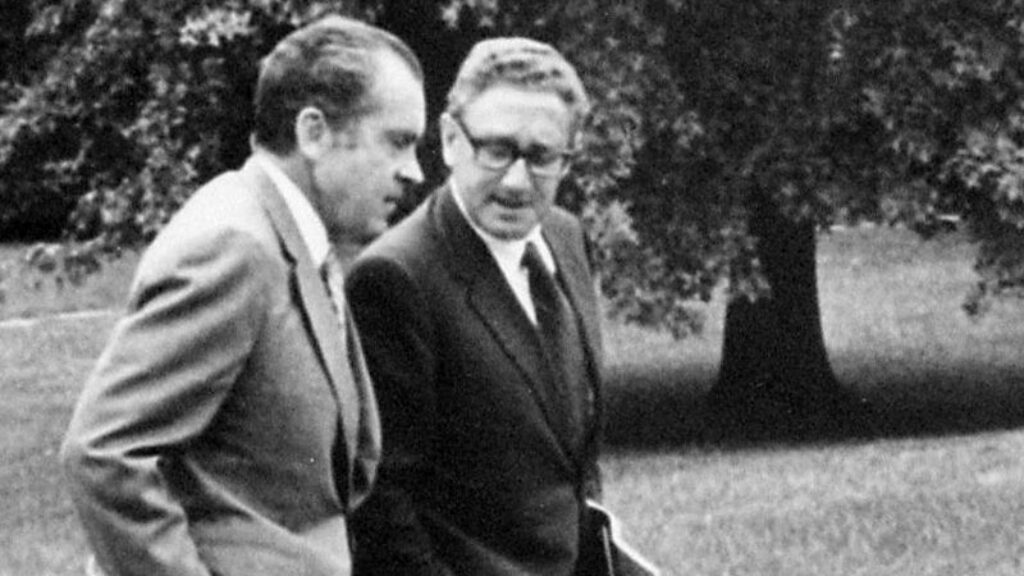
Tragedy and Power
Barry Gewen’s new book argues that Henry Kissinger's "hardheaded Realism” was born of his family’s tragic experience in Nazi Germany.
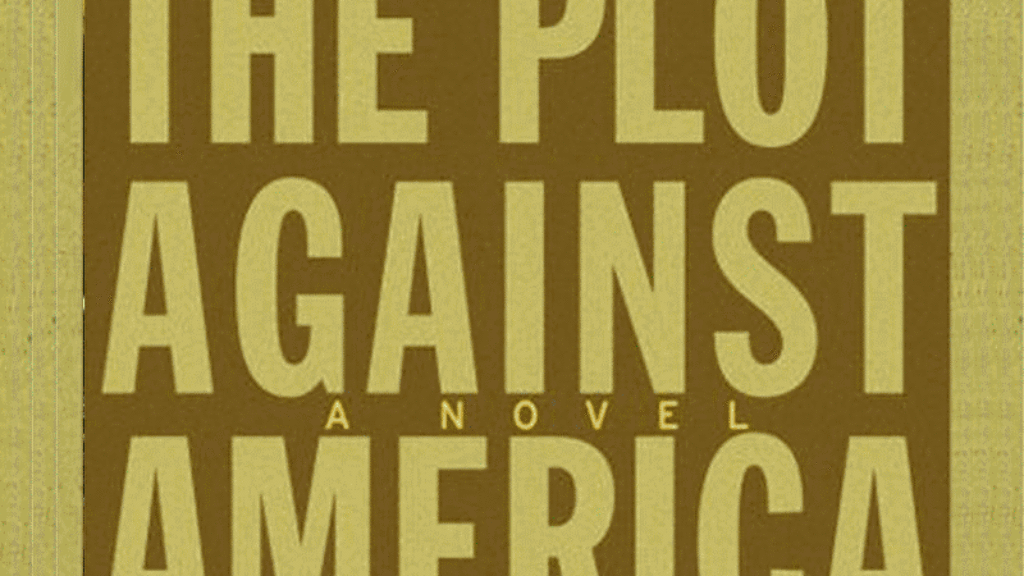
When Everything Matters
Bellow on Roth on TV.
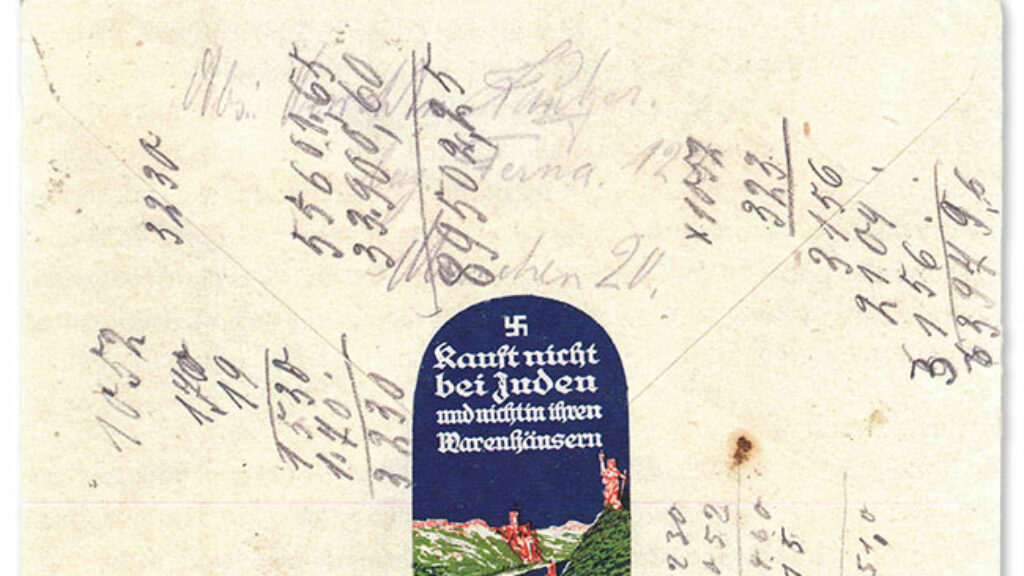
Postcards from the Shoah
Stamps and the paper they traveled on create a historical record of the Holocaust, capturing, for instance, “the exact historical moment when one person reached out in desperation to another."
Comments
You must log in to comment Log In